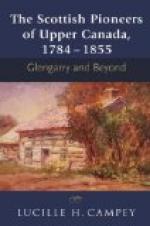The rest of the winter and early spring Champlain spent alone, or in company with Father Joseph Le Caron (one of the Recollet missionaries), visiting the Algonkin and Huron tribes in the region east of Lake Huron. He has left this description of the modern country of Simcoe, the home, three hundred years ago, of the long-vanished Hurons[30]; and gives us the following particulars of their home life. The Huron country was a pleasant land, most of it cleared of forest. It contained eighteen villages, six of which were enclosed and fortified by palisades of wood in triple rows, bound together, on the top of which were galleries provided with stores of stones, and birch-bark buckets of water; the stones to throw at an enemy, and the water to extinguish any fire which might be put to the palisades. These eighteen villages contained about two thousand warriors, and about thirty thousand people in all. The houses were in the shape of tunnels, and were thatched with the bark of trees. Each lodge or house would be about 120 feet long, more or less, and 36 feet wide, with a 10-foot passage-way through the middle from one end to the other. On either side of the tunnel were placed benches 4 feet high, on which the people slept in summer in order to avoid the annoyance of the fleas which swarmed in these habitations. In winter time they slept on the ground on mats near the fire. In the summer the cabins were filled with stocks of wood to dry and be ready for burning in winter. At the end of each of these long houses was a space in which the Indian corn was preserved in great casks made of the bark of trees. Inside the long houses pieces of wood were suspended from the roof, on to which were fastened the clothes, provisions, and other things of the inmates, to keep them from the attacks of the mice which swarmed in these villages. Each hut might be inhabited by twenty-four families, who would maintain twelve fires. The smoke, having no proper means of egress except at either end of the long dwelling, and through the chinks of the roof, so injured their eyes during the winter season that many people lost their sight as they grew old.
[Footnote 30: They were almost completely exterminated by the Iroquois confederacy between thirty and forty years after Champlain’s visit.]
“Their life”, writes Champlain, “is a miserable one in comparison with our own, but they are happy amongst themselves, not having experienced anything better, nor imagining that anything more excellent could be found.”
These Amerindians ordinarily ate two meals a day, and although Champlain and his men fasted all through Lent, “in order to influence them by our example”, that was one of the practices they did not copy from the French.




